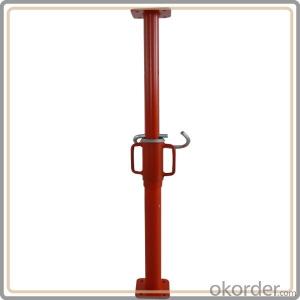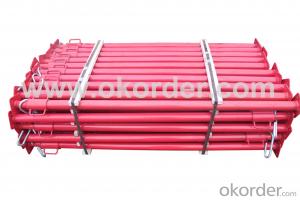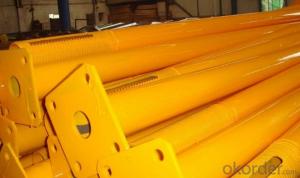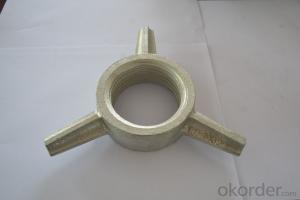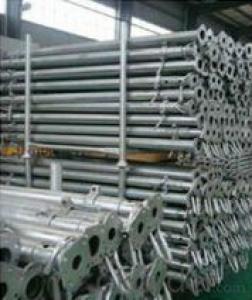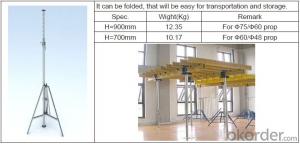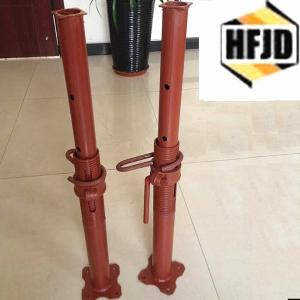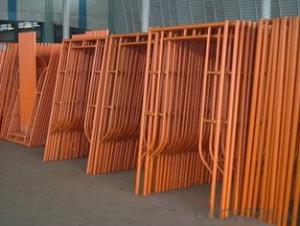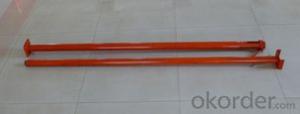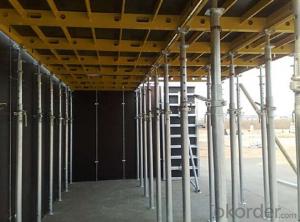Adjustable prop
- Loading Port:
- Tianjin
- Payment Terms:
- TT OR LC
- Min Order Qty:
- -
- Supply Capability:
- 150000 pc/month
OKorder Service Pledge
Quality Product, Order Online Tracking, Timely Delivery
OKorder Financial Service
Credit Rating, Credit Services, Credit Purchasing
You Might Also Like
Export adjustable props / Light duty shoring props
Type :SD2240/18IGSP
Height: 2200-4000mm
Outer tube diameter : 56mm
Inner tube diameter: 48mm
Thickness : 1.8mm
Middle duty nut : Italy type ( cup type )
Pin :G-lock
Weight : 11kg
Material : Q235
Surface :painted coated
Color : as customer 's request . red / blue / green / orange/ brown ,
Plate : Flower plate 120*120*5mm
- Q:What are the main advantages of using heavy-duty steel props?
- There are several main advantages of using heavy-duty steel props. Firstly, heavy-duty steel props are known for their exceptional strength and durability. Being made of high-quality steel, these props can withstand heavy loads and provide reliable support for various construction projects. Their robust construction ensures that they can withstand the pressures and demands of construction sites, making them a reliable choice for contractors and builders. Secondly, heavy-duty steel props offer great versatility. Their adjustable design allows for easy height adjustment, making them suitable for a wide range of applications and projects. Whether it is supporting formwork, beams, or slabs, heavy-duty steel props can be extended or retracted to the required height, providing flexibility and adaptability on construction sites. Another advantage of using heavy-duty steel props is their stability and safety. The strong steel construction ensures that these props can securely hold and support the weight of the structure or material they are used for. This helps to prevent accidents and collapses, providing a safe working environment for construction workers. Furthermore, heavy-duty steel props are cost-effective. Due to their durability and long lifespan, these props can be used repeatedly for multiple projects, reducing the need for frequent replacements or repairs. This helps to save costs in the long run and makes them a cost-effective choice for construction companies. Lastly, heavy-duty steel props are easy to use and assemble. Their simple design allows for quick and hassle-free installation, saving time and effort on construction sites. Additionally, their adjustable height feature allows for easy customization to meet specific project requirements. In conclusion, the main advantages of using heavy-duty steel props include their strength, versatility, stability, cost-effectiveness, and ease of use. These props provide reliable support for construction projects, ensuring safety and efficiency on the job site.
- Q:What are the different materials used for steel props?
- The different materials used for steel props typically include high-quality steel alloys, such as carbon steel or stainless steel. These materials are chosen for their strength, durability, and resistance to corrosion, making them suitable for supporting heavy loads and withstanding harsh environmental conditions.
- Q:How do steel props contribute to the prevention of floor and wall deflection?
- Steel props contribute to the prevention of floor and wall deflection by providing temporary support and stability during construction or renovation projects. These props are adjustable and can be installed vertically to bear the weight of the floors and walls, ensuring they remain in their intended position. By providing additional support, steel props help distribute the load evenly, minimizing deflection or sagging that could occur due to excessive weight or movement.
- Q:What are the potential legal or regulatory requirements for using steel props?
- The potential legal or regulatory requirements for using steel props may vary depending on the jurisdiction and specific industry. However, some common requirements could include ensuring compliance with workplace health and safety regulations, obtaining necessary permits or licenses for construction projects, adhering to building codes and standards, and conducting regular inspections and maintenance to ensure the props are safe and fit for use. It is important to consult with local authorities and relevant industry regulations to determine the specific legal or regulatory requirements for using steel props in a particular context.
- Q:Can steel props be used in the construction of temporary parking structures?
- Yes, steel props can be used in the construction of temporary parking structures. Steel props, also known as steel shores or steel supports, are commonly used in construction to provide temporary support and stability to structures during the construction process. They are adjustable and can be easily installed, making them ideal for temporary structures such as parking lots. Steel props are strong and durable, capable of supporting heavy loads, which is crucial in parking structures where vehicles will be parked. Additionally, steel props can be easily dismantled and reused, making them a cost-effective solution for temporary parking structures.
- Q:What are the common load testing procedures for steel props?
- Load testing procedures for steel props commonly involve the following steps: 1. Preparing the props: Before conducting load testing, it is important to ensure that the steel props are in good condition and free from any defects or damage. Any rust or corrosion should be removed, and all components should be properly assembled and secured. 2. Determining the load capacity: The load capacity of steel props should be determined based on the manufacturer's specifications or industry standards. This information can usually be found in the product manual or technical data sheet. It is crucial to adhere to these guidelines to ensure accurate load testing. 3. Setting up the test equipment: Load testing requires specialized equipment such as load cells, hydraulic jacks, or weights. The equipment should be properly calibrated and positioned to accurately measure the applied load. The props should be securely fixed in place to prevent any movement during the testing process. 4. Applying the load: The load should be gradually applied to the steel props in a controlled manner. This can be done by incrementally increasing the load using the chosen testing equipment. It is important to monitor the props throughout the process to ensure they are not exceeding their load capacity or displaying any signs of failure. 5. Monitoring and recording data: During the load testing, it is essential to continuously monitor the props and record relevant data such as applied load, deflection, and any visual changes or deformations. This data will help assess the performance and structural integrity of the steel props. 6. Analyzing the results: After completing the load testing, the gathered data should be analyzed to evaluate the props' performance. This analysis may involve comparing the recorded values against the manufacturer's specifications or industry standards. Any signs of failure, excessive deflection, or other anomalies should be carefully assessed and addressed. 7. Reporting and documentation: A comprehensive report should be prepared summarizing the load testing procedures, results, and any observations made during the process. This report should be securely stored as part of the project documentation for future reference. It is important to note that load testing procedures may vary depending on specific project requirements, industry standards, or regional regulations. Therefore, it is recommended to consult with relevant experts or follow specific guidelines provided by the steel prop manufacturer.
- Q:Do steel props require any special storage or handling procedures?
- Yes, steel props do require special storage and handling procedures. Steel props are commonly used in construction projects to provide temporary support to structures during construction or renovations. To ensure their longevity and safety, it is important to follow certain procedures when storing and handling steel props. Firstly, proper storage is crucial to protect steel props from environmental factors that can cause corrosion or damage. Steel props should be stored in a dry and well-ventilated area, away from moisture or direct sunlight. If they are not in use, it is recommended to keep them indoors or under a waterproof cover. Additionally, it is important to handle steel props carefully to prevent any accidents or injuries. When lifting or moving steel props, it is advisable to use appropriate lifting equipment such as cranes or forklifts, instead of manually lifting them. This ensures the props are not dropped, leading to potential damages or injuries. Furthermore, it is essential to inspect steel props before and after each use. Any signs of damage, including deformations, cracks, or excessive wear, should be addressed immediately. Damaged steel props should not be used and should be replaced or repaired to maintain the structural integrity and safety of the construction site. In conclusion, steel props do require special storage and handling procedures to ensure their longevity and safety. Following proper storage methods and handling practices, as well as regular inspections, will help prevent damage and maintain the quality of steel props, ultimately contributing to a safe and efficient construction process.
- Q:I would like to ask how the cost of steel support how the composition of the material composition of the number of what the size of the various specifications of how much raw materials are required
- Combined with the average domestic iron and steel enterprises, main factors influencing the total cost of the ironmaking process of raw materials (iron ore, coke and other costs) costs, recycling byproducts including materials, fuel, labor costs, offset only accounted for about 10% of the total cost and other expenses for the steelmaking process in addition to the main the raw materials increased, the power consumption of added alloy and maintenance costs rise accounted for about 18% of the total cost of steelmaking. Other fluctuations in the process of ironmaking, steelmaking.
- Q:What are the common maintenance practices for steel props?
- Common maintenance practices for steel props include regular cleaning and inspection to remove dirt, rust, and any other contaminants. It is important to lubricate the moving parts to prevent friction and ensure smooth operation. Regular checks should be conducted to identify any damage or wear and tear, and repairs or replacements should be made promptly. Additionally, storing the props in a dry and well-ventilated area helps to prevent corrosion and prolong their lifespan.
- Q:How do you secure steel props to prevent movement or collapse?
- To ensure the stability and prevent movement or collapse of steel props, it is necessary to follow several steps and precautions. The following measures can be employed: 1. Thorough selection: It is vital to choose steel props that can bear the intended load and meet the specific requirements of the construction project. These props should have the capacity to withstand anticipated loads and forces. 2. Proper positioning: Steel props should be placed at regular intervals along the structure, taking into account the expected load distribution. They must be positioned on a strong and stable foundation, such as concrete slabs or compacted ground. 3. Bracing: To enhance stability and prevent lateral movement, it is advisable to use diagonal or cross-bracing between the steel props. The bracing should be securely fastened to the props and offer additional support against potential collapses or shifts. 4. Anchoring: To secure the steel props, appropriate anchoring systems, such as anchor bolts, screws, or other fasteners, should be employed. These will firmly attach the props to the floor or adjacent walls. 5. Regular inspections: Periodic inspections of the steel props are necessary to ensure their integrity and identify any signs of damage or wear. This will help in detecting potential issues early on and avoiding accidents or collapses. 6. Monitoring and adjustment: Continuous monitoring of the loads and forces acting on the steel props during construction or subsequent alterations is essential. Adjustments or reinforcements should be made as required to maintain stability and prevent movements or collapses. 7. Compliance with safety standards: It is crucial to adhere to all safety regulations and standards during the installation and use of steel props. This includes following local building codes, industry standards, and any specific guidelines provided by the manufacturer. By implementing these measures, one can effectively secure steel props, minimize the risk of movement or collapse, and ensure the safety and stability of the structure during construction or any other relevant applications.
1. Manufacturer Overview |
|
|---|---|
| Location | |
| Year Established | |
| Annual Output Value | |
| Main Markets | |
| Company Certifications | |
2. Manufacturer Certificates |
|
|---|---|
| a) Certification Name | |
| Range | |
| Reference | |
| Validity Period | |
3. Manufacturer Capability |
|
|---|---|
| a)Trade Capacity | |
| Nearest Port | |
| Export Percentage | |
| No.of Employees in Trade Department | |
| Language Spoken: | |
| b)Factory Information | |
| Factory Size: | |
| No. of Production Lines | |
| Contract Manufacturing | |
| Product Price Range | |
Send your message to us
Adjustable prop
- Loading Port:
- Tianjin
- Payment Terms:
- TT OR LC
- Min Order Qty:
- -
- Supply Capability:
- 150000 pc/month
OKorder Service Pledge
Quality Product, Order Online Tracking, Timely Delivery
OKorder Financial Service
Credit Rating, Credit Services, Credit Purchasing
Similar products
New products
Hot products
Related keywords
